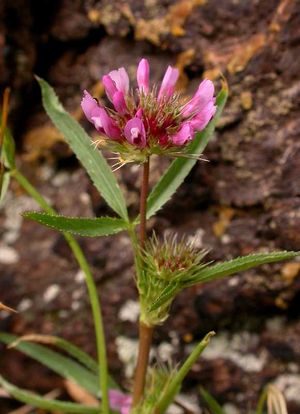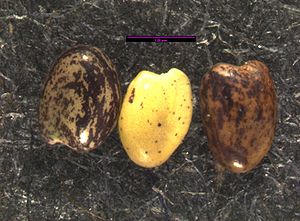Trifolium willdenovii
- Scientific Name: Trifolium willdenovii
- Family: Fabaceae.
- Common Names: tomcat clover, sand clover.
- Synonyms and misapplications: Trifolium tridentatum
- Codon: TRIWIL
Contents
Taxonomy
| Scientific classification | |
|---|---|
| Kingdom: | Plantae |
| Subkingdom: | Viridiplantae |
| Phylum: | Tracheophyta |
| Subphylum: | Spermatophytina |
| Class: | Magnoliopsida |
| Subclass: | Lilianeae |
| Order: | Fabales |
| Family: | Fabaceae |
| Genus: | Trifolium L. |
| Species: | Trifolium willdenovii V.G. Soukup |
| Synonyms | |
| |
Description
Annual herb from a taproot; stems 1 to several, spreading to erect, glabrous, 10-70 cm long/tall. Alternate, palmately compound; leaflets 3, linear to lance-oblong or elliptic, 1-4 cm long, the margins usually finely bristle-toothed; stipules egg-shaped, bristle-tipped, the upper jaggedly toothed, 1/3-1/2 as long as the leaflets. Inflorescence a head-like, stalked, axillary cluster of 6 to 60 pea-like flowers, the heads 1-3 cm wide, set in wheel-like, irregularly and jaggedly toothed involucres; corollas lavender to purple, 10-13 mm long; calyces 6-10 mm long, shiny and often purplish, the tube 15- to 25-veined, the lanceolate teeth slightly shorter than the tube, bristle-tipped, entire or with 2 teeth flanking the base of the bristle. Fruit are pods; seeds 1 to 2. [1]
Bloom Period
April-June
Distribution
West side of the Cascades and east along the Columbia River in Washington; British Columbia south to California. [2]
Habitat
Grassy hillsides, balds, prairies and meadows at low to moderate elevations. [2]
Uses
Seeds used for food; Young, tender plants eaten uncooked as greens; Raw or steamed buds eaten before plant bloomed; Steamed, dried leaves soaked in water or boiled before eating in winter. [2]
Propagation
Seeds are germinated during late winter and early spring months in a shadehouse were they remain for several weeks. Seeds are directly sown into flats filled with a 1 inch layer of special seed germination mix of 1:1 (v:v) Sunshine Professional Growing Mix and sand on top of 4:1:1 (v:v:v) peat, perlite, and organic compost.
Seed
Seed sample from: 2011
Average Measurement: 1.6 x 1.1 x 1.1
Measurement Range: L: 1.5 - 2, W: 1 - 1.3, D: 1 - 1.1
Features
Shape: Flattened egg shape. Hilum is small circular divot seated between a protruding lobe.
Color: Seed background gray/brown, sometimes speckled with dark brown.
Surface: Smooth and glossy.
Latitudinal Cross Section: elliptical ![]()
Longitudinal Cross Section: elliptical ![]()
Basic Explanations and Assumptions:
The dimensions for the seeds are length x width x depth. The location of the hilum is used as the base of the seed, and the length is measured from hilum to the opposite apex. Where a style is present, the length is measured from the hilum to the bottom of the style. Width is measured at a right angle to the length at the widest part. Depth is measured at a right angle to the intersection of height and width lines.
Measurements included are the mean average for each measurement of ten separate seeds.
All measurements in millimeters unless otherwise noted.
Photo Gallery
References
Herrera, Mike; Takara, Janet. 2006. Propagation protocol for production of container Trifolium willdenovi Spreng. ' ' plants (Deepot 40 (40 cubic inch)); Catalina Island Conservancy, Avalon, California. In: Native Plant Network. URL: http://www.nativeplantnetwork.org (accessed 25 September 2006). Moscow (ID): University of Idaho, College of Natural Resources, Forest Research Nursery. http://biology.burke.washington.edu/herbarium/imagecollection.php





